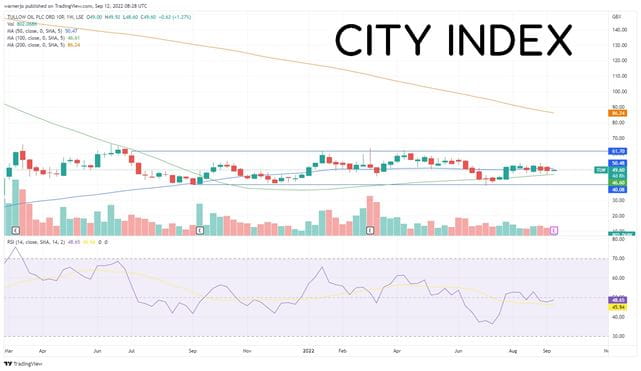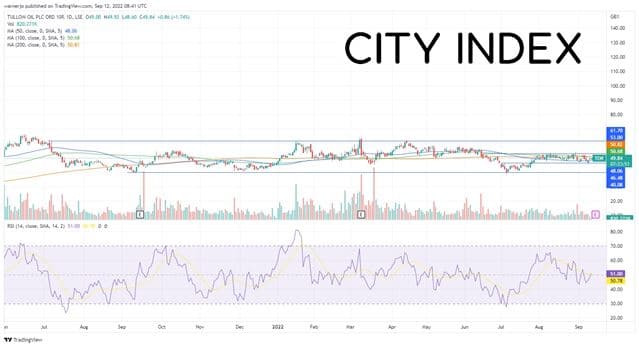
When will Tullow Oil release H1 earnings?
Tullow Oil will release first half earnings on the morning of Wednesday September 14.
Tullow Oil H1 earnings consensus
Analysts forecast that Tullow Oil will report a 14% year-on-year rise in revenue in the first half of 2022 to $828.8 million. Profit after tax – its headline measure - is forecast to jump almost 48% to $137 million.
Tullow Oil H1 earnings preview
We already know that production came in at 60,900 barrels per day (bopd) in the first half. That was ahead of the 59,950 bopd expected by analysts but down from the 61,230 bopd produced the year before. Revenue is set to rise 14% in the first half as higher prices make up for the drop in output.
However, the drawback of Tullow right now is its hedging programme. It has hedged 42,500 bopd in 2022 at a weighted average sold call of $78 per barrel, well below current spot prices with Brent trading at over $92 per barrel at present. For example, it achieved an average oil price of $106 per barrel in the first half but this fell to just $87 once its hedging programme is taken into account. Although hedging can help guarantee income, it is not paying off this year. Tullow is set to sell 65% to 72% of its production this year at below optimal prices (assuming oil prices remain elevated), preventing it from reaping the same level of rewards as other oil companies without vast hedging programmes.
Tullow Oil is aiming to produce 59,000 to 65,000 bopd over the full year, with the increase set to be mostly driven by the pre-emption in Ghana that will increase its share of output by around 4,000 bopd.
With that in mind, Tullow is still spending some $380 million in capital expenditure in 2022, a sharp rise from the $263 million spent in 2021 as it accelerates drilling in Ghana, and yet output could still come in-line with the 59,200 bopd delivered in 2021 before the pre-emption is included. As a result of higher spending, free cashflow will fall to around $200 million this year from the $245 million seen last year.
Tullow Oil and Capricorn Energy merger: is it in doubt?
Tullow Oil agreed to merge with fellow London-listed firm Capricorn Energy at the start of June in an all-share deal. The ‘merger of equals’ will see Capricorn Energy shareholders own 47% of the combined company and the rest held by Tullow Oil investors. This will create a leading energy company in Africa that, based on last year’s output, can produce around 96,000 bopd and expands the number of growth prospects across the continent. This includes Tullow’s project in Kenya, where it is still looking for a partner to help develop it, as well as growth opportunities in Guyana, Mauritania and Egypt.
For Tullow, one of the big attractions of the deal is the ability to deleverage itself as it tries to bring leverage down to 1.5x (from 2.2x at the end of 2021) by using Capricorn’s healthier balance sheet. The pair plan to discover $50 million of annual cost synergies once completed. Notably, the merger will also allow the pair to establish ‘sustainable shareholder returns’ underpinned by a $60 million base annual dividend and accompanied by the potential for additional returns to be made.
There has been some push back against the deal. A number of investors, which together own around 27% of Capricorn Energy, have said they plan to vote against the merger. That is significant considering the pair will need to secure the backing of at least 75%. They do not see the same rationale and believe the synergies are not good enough to warrant a merger.
‘The transaction undervalues Capricorn, benefits Tullow at our expense, and trades the certainty of our cash for speculative Tullow stock,’ a managing partner at shareholder Madison Avenue Partners told Bloomberg last month.
Capricorn appears to be feeling the pressure. The company said last week when it released its own set of first half results that it is supporting the deal but considering other options.
‘The board continues to believe that the proposed merger with Tullow can deliver significant long-term value for shareholders through creating a leading, Africa-focused energy company. The board is also mindful of the impact of external factors and market conditions and is, as always, assessing all options to maximise value for shareholders. The company is exploring a number of expressions of interest relating to alternative transactions, and is engaging with those parties expressing interest to evaluate potential outcomes,’ said Capricorn CEO Simon Thomson.
That sets a cautious tone ahead of the shareholder vote on the deal before the end of 2022.
Where next for the Tullow Oil share price?
The weekly chart shows the stock has drifted between a ceiling of 61.70p and a floor of around 40.0p for over a year, which should be treated as the ultimate up-and-downside targets going forward until the share price breaks out of this weekly range.

This range can also be seen on the daily chart, but we can see it has narrowed in recent months, with the stock firmly stuck between a 53.0p level of resistance and a 46.70p level of resistance-turned-support since June. These should be treated as the initial targets to watch out for before the weekly targets come back into play.

How to trade the Tullow Oil share price
You can trade Tullow Oil shares with City Index in just four easy steps:
- Open a City Index account, or log-in if you’re already a customer.
- Search for ‘Tullow Oil’ in our award-winning platform
- Choose your position and size, and your stop and limit levels
- Place the trade
Or you can try out your trading strategy risk-free by signing up for our Demo Trading Account.





